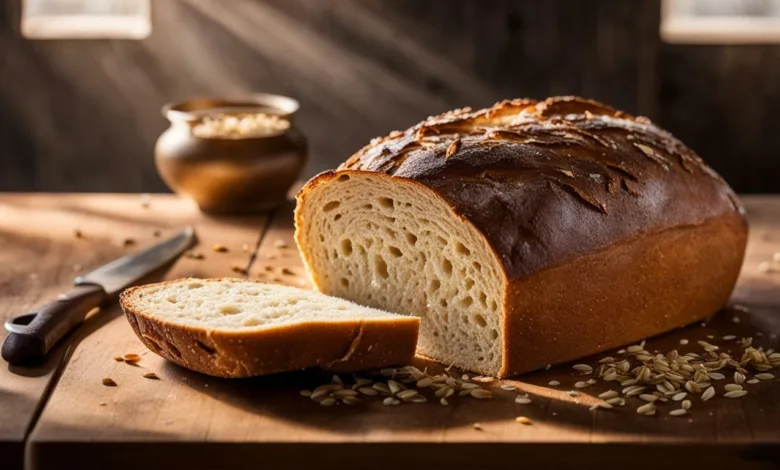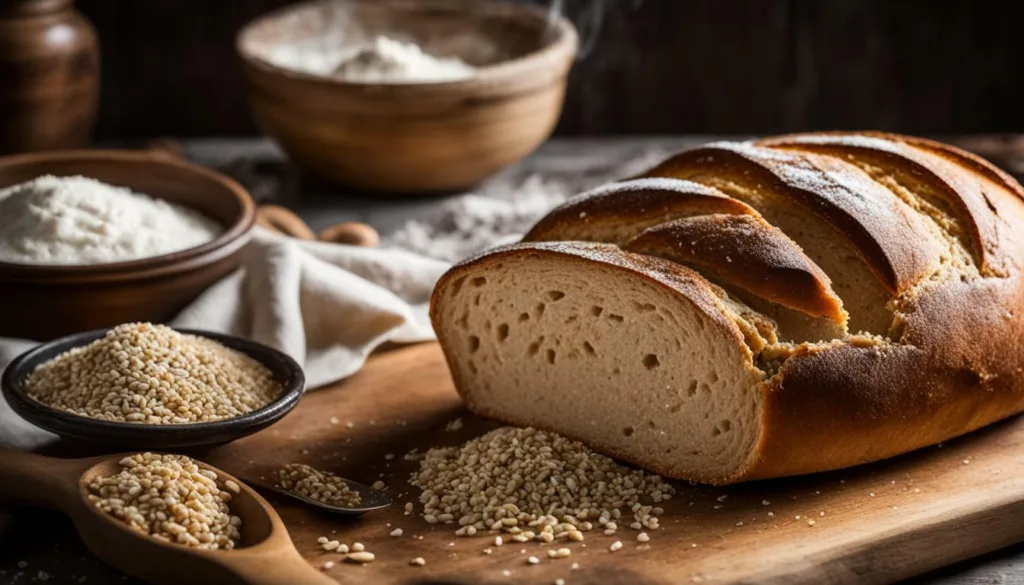Homemade Sourdough Bread: Crusty and Delicious

Welcome to the wonderful world of homemade sourdough bread! If you’ve never tried baking your bread before, you’re in for a treat. Nothing quite compares to the satisfaction of pulling a crusty, golden loaf out of the oven and savoring the aroma that fills your kitchen. In this section, we’ll dive into the art of making homemade sourdough bread and provide you with tips and tricks to make it a success.
- Homemade sourdough bread is a satisfying and rewarding experience.
- With the right ingredients and techniques, you can easily make your own crusty and delicious loaf.
- Understanding the process of sourdough bread baking is essential to achieving excellent results.
- Natural yeast and fermentation play a crucial role in creating the unique flavor and texture of sourdough bread.
- Achieving the perfect crust requires attention to temperature and moisture control.

The Art of Sourdough Bread Baking
There’s something special about homemade bread, and sourdough bread in particular. The tangy flavor and crusty texture can be hard to resist. If you’re new to bread baking, don’t worry – we’ve got a simple sourdough bread recipe that you can make at home.
- The first step is to gather your ingredients. You’ll need flour, water, salt, and of course, a sourdough starter. If you don’t have a starter, you can easily make one by mixing flour and water and letting it sit at room temperature for a few days until it starts to ferment.
- Next, mix the ingredients in a large bowl and knead the dough until it becomes smooth and elastic.
- Let it rest for a few hours until it rises, then shape it into a loaf and let it rise again.
- Finally, bake in a preheated oven until it’s golden brown and crusty.
Bread baking can seem intimidating, but with a little practice and patience, anyone can master the art of sourdough bread. And the best part is, you don’t need any fancy equipment – just a mixing bowl, your hands, and an oven.
Homemade bread is a simple pleasure that’s hard to beat. From the aroma of freshly baked bread filling your home to the satisfaction of breaking off a warm slice, there’s nothing quite like it. So why not give our sourdough bread recipe a try and discover the joy of homemade bread baking?
There is something truly special about the taste of homemade sourdough bread. The tangy, slightly acidic flavor is thanks to the power of natural yeast. Unlike commercial yeasts, natural yeast is created through the process of fermentation and adds a unique depth of flavor to your bread.
Creating a sourdough starter is the key to harnessing the power of natural yeast. A sourdough starter is made up of flour and water that has been allowed to ferment over several days. This process creates a living culture of yeast and bacteria that can be used to leaven bread dough.

Secrets to Achieving Crust Perfection
Creating a crusty exterior that is both crispy and chewy is an essential aspect of artisan bread baking. Follow these expert tips to achieve crust perfection in your homemade sourdough bread:
- Temperature control: Maintaining the right temperature in your oven is crucial to achieving the perfect crust. Preheat your oven to at least 450°F and bake your bread on a preheated stone or Dutch oven to create a steamy environment that promotes crust development.
- Steam: Adding steam to your oven during the first few minutes of baking will help create a crusty exterior. You can create steam by placing a pan of water on the bottom rack of your oven or by spritzing water into the oven with a spray bottle. Just be careful not to spray water directly onto the heating element or glass of your oven.
- Baking time: Baking your bread for the right amount of time is essential to achieving the perfect crust. A golden-brown color indicates that your bread is done baking, and the internal temperature should reach at least 200°F.
- Cooling: After baking, allow your bread to cool completely before slicing. This helps the crust to set and become crispy.
With these tips, you can achieve a perfect crust every time, making your homemade baking rival that of artisan bakeries.
Reheating Your Bread
If you’ve stored your bread properly, you can enjoy it for several days after baking. But what about reheating it to recapture that fresh-out-of-the-oven taste?
Preheat your oven to 350°F (175°C). Wrap your bread in foil and place it in the oven for 10-15 minutes. If you want a crustier loaf, remove the foil for the last 5 minutes of baking. Another option is to slice your bread and toast it in a toaster or toaster oven. Either way, you’ll have a warm, delicious slice of fresh bread in no time.





